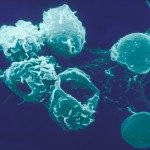Link to Pubmed [PMID] – 34722824
Link to DOI – 10.21769/BioProtoc.4177
Bio Protoc 2021 Oct; 11(19): e4177
The formation of spheroids with mesenchymal stem/stromal cells (MSCs), mesenchymal bodies (MBs), is usually performed using bioreactors or conventional well plates. While these methods promote the formation of a large number of spheroids, they provide limited control over their structure or over the regulation of their environment. It has therefore been hard to elucidate the mechanisms orchestrating the structural organization and the induction of the trophic functions of MBs until now. We have recently demonstrated an integrated droplet-based microfluidic platform for the high-density formation and culture of MBs, as well as for the quantitative characterization of the structural and functional organization of cells within them. The protocol starts with a suspension of a few hundred MSCs encapsulated within microfluidic droplets held in capillary traps. After droplet immobilization, MSCs start clustering and form densely packed spherical aggregates that display a tight size distribution. Quantitative imaging is used to provide a robust demonstration that human MSCs self-organize in a hierarchical manner, by taking advantage of the good fit between the microfluidic chip and conventional microscopy techniques. Moreover, the structural organization within the MBs is found to correlate with the induction of osteo-endocrine functions (i.e., COX-2 and VEGF-A expression). Therefore, the present platform provides a unique method to link the structural organization in MBs to their functional properties. Graphic abstract: Droplet microfluidic platform for integrated formation, culture, and characterization of mesenchymal bodies (MBs). The device is equipped with a droplet production area (flow focusing) and a culture chamber that enables the culture of 270 MBs in parallel. A layer-by-layer analysis revealed a hierarchical developmental organization within MBs.




